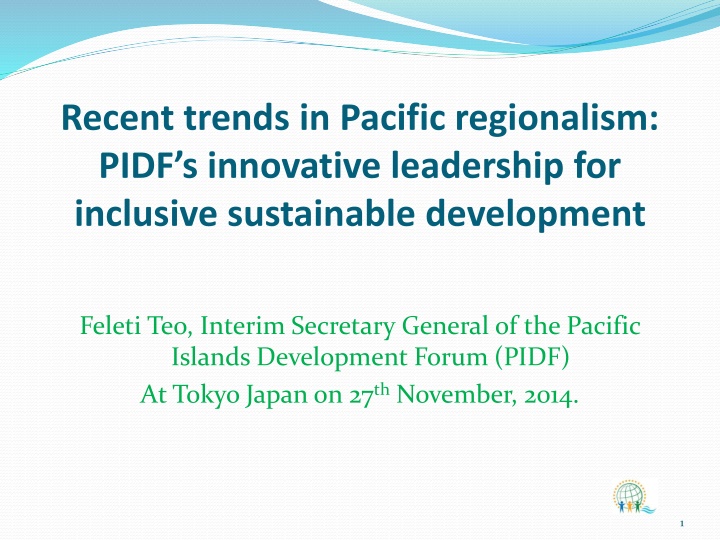
Pacific Regionalism: PIDF's Innovative Leadership for Sustainable Development
Explore recent trends in Pacific regionalism through the lens of PIDF's innovative leadership for inclusive and sustainable development. Learn about PIDF's strategic profile, institutional arrangements, work program, green growth initiatives, and its relationships with other regional organizations.
Download Presentation

Please find below an Image/Link to download the presentation.
The content on the website is provided AS IS for your information and personal use only. It may not be sold, licensed, or shared on other websites without obtaining consent from the author. If you encounter any issues during the download, it is possible that the publisher has removed the file from their server.
You are allowed to download the files provided on this website for personal or commercial use, subject to the condition that they are used lawfully. All files are the property of their respective owners.
The content on the website is provided AS IS for your information and personal use only. It may not be sold, licensed, or shared on other websites without obtaining consent from the author.
E N D
Presentation Transcript
Recent trends in Pacific regionalism: PIDF s innovative leadership for inclusive sustainable development Feleti Teo, Interim Secretary General of the Pacific Islands Development Forum (PIDF) At Tokyo Japan on 27thNovember, 2014. 1
Outline of Presentation Background Why and what is PIDF Strategic profile Institutional arrangements Work programme Pacific green growth initiatives Relationships with other RO Conclusion 2
Background UNCED (1992) involvement of social groups in decision making RIO+20 (2012) the Future We Want strengthen multi-stakeholder bodies and processes Governments don t have monopoly over SD RO are Intergovernmental and sector specific Emergence of PSIDS and S-S groupings Engaging with the Pacific conference 3
Mandate Approved by 2012 EWTP: "Endorsed the convening of the Pacific Islands Development Forum for the purpose of engaging leaders from key sectors in implementing green economic policies in PSIDS (Source: Official Communiqu ) Leaders Present: Papua New Guinea Fiji Kiribati Nauru Cook Islands Timor Leste Tuvalu Federated States of Micronesia French Polynesia Marshall Islands New Caledonia Solomon Islands Tonga Vanuatu 4
Why PIDF Absence of a regional multi-stakeholder platform Absence of a genuine PSIDS space Absence of a regional counterpoints for South-South groupings Absence of a dedicated regional platform for Pacific green-blue economies 5
What is the PIDF Pacific only regional multi- stakeholder (HLPF) Regional counterpoint to PSIDS UN Missions Pacific counterpoint for South-South (G77 plus China, AOSIS) Pacific regional platform for green-blue economies platform groupings 6
PIDF Vision A United, Distinctive and Sustainable Pacific Society United All Pacific People. Distinctive Only Pacific People Sustainable A Pacific Society that has re- balanced the three pillars of development. 8
PIDF Mission Enabling Green Blue Pacific Economies through Inclusive Strategies, Multi-stakeholder Governance, and Genuine Partnerships. Multi- stakeholder Governance Inclusive Strategies Genuine Partnerships Green/Blue Pacific Economies 9
PIDF Purpose To drive, through regional and national frameworks, transformative changes by focusing exclusively on the sustainable and inclusive development of the PICs by: Accelerate integration of 3 pillars of development Facilitate use of tools and innovations Transformative changes 10
PIDF Function Serve as a dynamic regional partnership platform where leaders and representatives of PICs take ownership of their decisions and actions to address their special development needs Serve as the Pacific regional counterpart for the south-south groupings and other regional and international arrangements that focus exclusively on the sustainable development of SIDS Provide for an inclusive regional multi-stakeholder forum for leaders of governments, private sector and civil society 11
Institutional arrangements Transitional arrangements PIDF Agreement Governance arrangements Coverage under Fiji Diplomatic Privileges and Immunities Act 1971 Host Country Agreement signed 20/6/14 Secretariat office opening: 26 April 2014 Guiding Principle: Less is more and more for less Staff: 8 12
Stewardship Leadership Annual Summit Leaders Council Executive Board 2014 Leaders Council Senior Officials Committee Secretariat 13
PIDF Work Program 2014-2017 Outputs Outcome Impact Inclusive and stewardship leadership at all levels for transformative change in support of green- blue Pacific economies Regional and national frameworks implementing effective transformation of unsustainable development practices through the use of innovative tools such as green-blue economy, adaptive leadership, and genuine partnerships for Pacific communities Enabling green-blue Pacific economies through inclusive strategies, multi- stakeholder governance, and genuine partnerships The public sector, private sector and civil society in PIDF countries have access to innovative practices and approaches that support green-blue economies Genuine, equitable and durable partnerships in place that support green-blue economies 14
Genuine Partnerships IUCN USP MSG SPC WWF 16
Pacific green growth initiatives VANUATU GREEN GROWTH DIALOGUE TONGA /HA APAI ROUNDTABLE MICRONESIA C.E SUMMIT FIJI NATIONAL ECONOMIC SUMMIT SOLS PM ROUNDTABLE PACIFIC GREEN GROWTH COALITION PIDF PNG DEV. FORUM 17
Relationships with other ROs Complimentary Fill the void in the regional architecture Focus exclusively on green-blue economies PIDF PIF can co-exist 18
Conclusion Genuine regional PSIDS space Pacific people taking ownership of their development needs, challenges and solutions. first representative and participatory regional platform on green growth (multi-stakeholder). Pacific s and truly Pacific counterpart for regional and global groupings. South South 19
Thank you Questions 20
